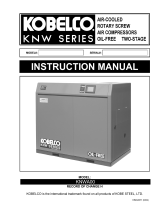Page is loading ...

thermaltransfer.com ttp-sales@apiheattransfer.com +1.262.554.8330
Installation
The satisfactory use of this heat exchange equipment is dependent upon
certain precautions which must be taken at the time of the installation.
1. Aftercoolers can be mounted in either of the positions shown. Separators
should be used as shown above.
2. If an automatic water regulating valve is used, place it on the INLET end of
the cooler. Arrange the water outlet piping so that the exchanger remains
flooded with water, but at little or no pressure. The temperature probe is
placed in the air line from the aftercooler to sense a system temperature rise.
Please contact factory for water regulating valve recommendations.
It is recommended that a water strainer be installed ahead of this aftercooler
when the source of cooling water is from other than a municipal water
supply. Dirt and debris can plug the water passages very quickly, rendering
the aftercooler ineffective. Please contact factory for water stainer
recommendations.
3. A separator/trap/drain should be installed in the outlet piping of the
aftercooler to remove the condensate.
4. All piping to the aftercooler should be properly aligned and supported to avoid
stress to the unit. A flexible metal hose should also be installed between the
aftercooler and compressor to isolate damaging vibration.
5. CAUTION If sealant tape is used on pipe threads, the degree of resistance
between mating parts is less, and there is a greater chance for cracking the
aftercooler castings. Do not over tighten.
6. Never exceed maximum flow rates or ratings.
Cooling Water Out
From
Compressor
Cooling Water In
Separator
To Receiver
Cooling
Water
Out
From
Compressor
Cooling
Water
In
To Receiver
Separator
Cooling Water Out
From
Compressor
Cooling Water In
Separator
To Receiver
Cooling
Water
Out
From
Compressor
Cooling
Water
In
To Receiver
Separator
AB Series
Service
Each aftercooler has been cleaned at the factory and should not require
further treatment. It may be well to inspect the unit to be sure that dirt or foreign
matter has not entered the unit during shipment. The aftercooler should be
mounted rigidly in place with pipe connections tight.
Performance information should be noted and recorded on newly installed units
so that any reduction in effectiveness can be detected. Any loss in efficiency
can normally be traced to an accumulation of water scale or deposits.
When storing the unit, be sure to keep the air and water ports sealed. If storage
continues into the cold winter months, the water chamber must be drained to
prevent damage by freezing.
Replace gaskets when removing end castings.
0916
/








